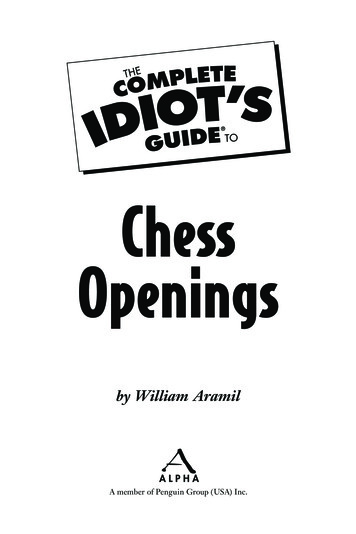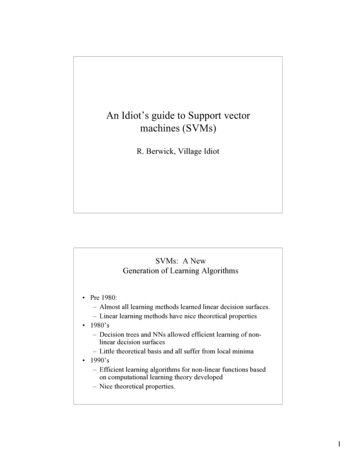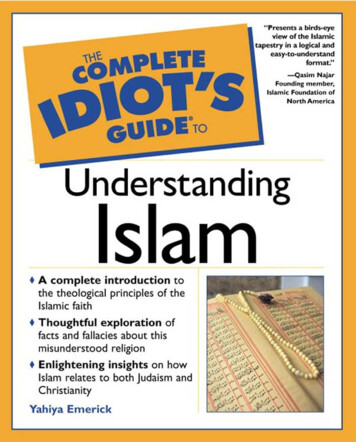
Transcription
ChessOpeningsby William AramilA member of Penguin Group (USA) Inc.
ChessOpenings
ChessOpeningsby William AramilA member of Penguin Group (USA) Inc.
ALPHA BOOKSPublished by the Penguin GroupPenguin Group (USA) Inc., 375 Hudson Street, New York, New York 10014, USAPenguin Group (Canada), 90 Eglinton Avenue East, Suite 700, Toronto, Ontario M4P 2Y3, Canada (a divisionof Pearson Penguin Canada Inc.)Penguin Books Ltd., 80 Strand, London WC2R 0RL, EnglandPenguin Ireland, 25 St. Stephen’s Green, Dublin 2, Ireland (a division of Penguin Books Ltd.)Penguin Group (Australia), 250 Camberwell Road, Camberwell, Victoria 3124, Australia (a division of PearsonAustralia Group Pty. Ltd.)Penguin Books India Pvt. Ltd., 11 Community Centre, Panchsheel Park, New Delhi—110 017, IndiaPenguin Group (NZ), 67 Apollo Drive, Rosedale, North Shore, Auckland 1311, New Zealand (a division ofPearson New Zealand Ltd.)Penguin Books (South Africa) (Pty.) Ltd., 24 Sturdee Avenue, Rosebank, Johannesburg 2196, South AfricaPenguin Books Ltd., Registered Offices: 80 Strand, London WC2R 0RL, EnglandCopyright 2008 by William AramilAll rights reserved. No part of this book shall be reproduced, stored in a retrieval system, ortransmitted by any means, electronic, mechanical, photocopying, recording, or otherwise, withoutwritten permission from the publisher. No patent liability is assumed with respect to the use of theinformation contained herein. Although every precaution has been taken in the preparation of thisbook, the publisher and author assume no responsibility for errors or omissions. Neither is anyliability assumed for damages resulting from the use of information contained herein. For information, address Alpha Books, 800 East 96th Street, Indianapolis, IN 46240.THE COMPLETE IDIOT’S GUIDE TO and Design are registered trademarks of PenguinGroup (USA) Inc.ISBN: 1-4406-5181-7Library of Congress Catalog Card Number: 2008924715Note: This publication contains the opinions and ideas of its author. It is intended to providehelpful and informative material on the subject matter covered. It is sold with the understandingthat the author and publisher are not engaged in rendering professional services in the book. If thereader requires personal assistance or advice, a competent professional should be consulted.The author and publisher specifically disclaim any responsibility for any liability, loss, or risk,personal or otherwise, which is incurred as a consequence, directly or indirectly, of the use andapplication of any of the contents of this book.Publisher: Marie Butler-KnightEditorial Director: Mike SandersSenior Managing Editor: Billy FieldsAcquisitions Editor: Michele WellsDevelopment Editor: Nancy LewisProduction Editor: Kayla DuggerCopy Editor: Amy LeporeCartoonist: Steve BarrBook Designer: Trina WurstIndexer: Tonya HeardLayout: Chad DresslerProofreader: John Etchison
Contents at a GlancePart 1:Part 2:Part 3:Chess Opening Fundamentals11 For Openers An introduction to the board, coordinates,and how the moves of a game are written.Also, what openings are and their overallgoals.32 The Basic Elements of Chess OpeningsThe five elements to help guide youthrough every opening move.173 The Elements in MotionThe elements are applied and analyzed ina famous game.331)e4 Openings434 1)e4 e5Openings beginning with 1)e4 e5, excluding the Ruy Lopez.455 Ruy LopezThe king of all openings in the history ofchess.596 The Dynamic SicilianThe sidelines and alternatives of thetrendiest opening in chess today.757 SicilianairesThe most fashionable starting positionwithin the Sicilian Defense.858 The Narrow, French, and CaroMostly hypermodern defenses for Black.971)d4 Openings9 1)d4 d5The well-known Queen’s Gambit andSlav Defense.109111
10 1)d4 Nf6Some of the less popular and semipopularlines after the position 1)d4 Nf6.11 The Nimzo, the Bogo, and the Queen’sIndianA champion’s defense against 1)d4.12 Hey Grunfeld, This KID Means Business!Systems where Black castles kingside anddevelops quickly.Part 4:Opening Choices13 Building an Opening RepertoireHow to choose an opening and avoid badhabits.125133145159161AppendixesA Glossary173B Advancing to the Next Level177Index181
ContentsPart 1: Chess Opening Fundamentals1 For Openers 13A Chess Player’s Tool. 3The Coordinates. 4Files, Ranks, and Diagonals. 5Notation. 6Name That Square. 6Move Numbers. 8This or That. 8Writing Special Moves. 10Symbols. 12The Opening vs. an Opening?. 13Opening Names. 14A Good Beginning. 15The Goal. 152 Basic Elements of Chess Openings17Material. 18Time. 18Space. 19Seizing Squares. 19I Have Space and . 20Help, I Can’t Breathe. 21Pawn Structure. 21The Soul of Chess. 22Pawn Chains. 22Pawn Islands. 23Isolated Pawn. 24Backward Pawn. 24Two Many. 25King Safety: The Trump Card. 263 The Elements in Motion33Analyzing Opening Variations. 34
viii The Complete Idiot’s Guide to Chess OpeningsPart 2: 1)e4 Openings434 1)e4 e545Petrov Defense. 46Scotch Game . 49Italian Game. 513) Bc5. 513 Nf6. 565 Ruy Lopez59Side of the Ruy. 603) Bc5 . 60Berlin: 3) Nf6. 63Exchange Variation: 4)Bxc6. 66The Main Game. 696 The Dynamic Sicilian752nd Best. 76Smith-Morra. 76The c3 Sicilian. 772)Nf3. 794) Nf6. 804) a6. 812) Nc6. 827 Sicilianaires85Classical Sicilian. 87The Sicilian Dragon: Love and Hate. 89Najdorf. 938 The Narrow, French, and Caro97The Narrow. 98Alekhine Defense: 1) Nf6. 98Center Stage. 100French Fighters?!. 101Advance Variation. 102A Knightmare . 104Caro-Kann. 105The Advance. 106Main Line. 107
ixContentsPart 3: 1)d4 Openings1099 1)d4 d5111Queen’s Gambit. 112I Accept!. 113No Thanks!. 115The Slav. 117The Others. 118S.S. the Semi-Slav. 119The Slav Accepts. 12210 1)d4 Nf6125Are You Hungary?. 126Benko Gambit. 128Benoni. 13011 The Nimzo, the Bogo, and the Queen’s Indian1333)Nc3. 134The Main Line. 1353)Nf3. 138The Bogo Is Not Bogus. 139Queen’s Indian. 14112 Hey Grunfeld, This KID Means Business!145The Grunfeld. 1467) c5. 1477) 0-0. 150The KID. 151Fianchetto System. 151The Classic KID. 154Part 4: Opening Choices13 Building an Opening Repertoire159161Selecting Openings. 162Solid and Sound. 162Charge!. 163Risky Gambits. 165The Quick Win. 166
The Effect of Surprise. 168Practicality. 169The Long Shots. 169Inventions. 170Opening Improvement. 171Results Now!. 171Learning the Right Way. 171Your Choice. 172AppendixesA Glossary173B Advancing to the Next Level177Index181
ForewordIn keeping with the spirit of satire implied by the word “idiot,” National Master William Aramil produces a wonderfully readable chessbook here. While the game of chess has a reputation of being played byrocket scientists and such, the truth is that people of all backgroundsexcel at the royal game all around the world. Time-tested chess principles are passed down through the generations, and by writing a bookto train the novice, William takes on a truly worthy task. Every worldchampion has, at some point, been a novice!NM William Aramil himself made it to the top of the chess community for his moment in time when he won first place in the DenkerTournament of High School Champions in 2003. The American chessscene has become a truly international mix of players from around theworld, particularly with many Russian Grandmasters and their offspring living and competing in America. The point is that, in attaining first place in the national event, William won not only a universityscholarship but a place in history along with every yearly winner whoplays in honor of the late, great Grandmaster Arnold Denker. Onecould go on to find other accomplishments in William’s young career,but another point here is the matter of style.Few people not well acquainted with chess realize that chess can bringregional and cultural style along with it. Perhaps few people are awareof the superb chess legacies of strong players from the Philippinesor their fresh attacking style! William, being of Filipino-Americandescent, is no exception, and his attacking prowess and accurate boardvision make him a powerful enemy at the chessboard, no matter whatskill level the opponent. I have vivid memories of losing two importantblitz (5-minute) games in an official event in Las Vegas to the youngchess wunderkind, much to my disappointment. Along with a slashing,attacking style of his own, William has a strong grip on all phases ofthe game, including defensive techniques. He has much to teach as achess trainer and, now, an author. This work will take the reader on ajourney from beginner to intermediate, and the lessons taught here willcontinue to apply for a lifetime. Experienced players also would do wellto read the book, and it is clear that the principles and variations contained herein apply equally to all who play chess.
One of the many wonderful things about the royal game is its applicability to real life and decision-making. How many times have you heardthe phrase, “Life is a chess game”? Young and old will learn time-testedlessons in the dance of the lively pieces, as mate is delivered or parriedin cut-and-thrust battle. Slow positional ideas will reveal themselvesas maneuvers unfold across the chessboard, shaped by clear thinking.With a strong background into the workings of chess, the goddess ofchess Caissa herself will smile as the novice becomes the dangerousintermediate player. Perhaps future Grandmasters will one day lookback at such auspicious beginnings as offered by this book. Either way,the game and its inherent beauty and knowledge will march forwardinto human generations until Father Time himself adjourns the game.—International Master Emory Andrew Tate Jr.Emory Andrew Tate Jr. is a world-renowned chess player and linguist still active on the difficult chess circuit. Six-time Indiana StateChampion and five-time Armed Forces Champion of the United States,Tate incorporates an inimitable tactical style with a deep understandingof chess principles. Emory played a small but important role in trainingWilliam Aramil as a youth and takes pleasure in William’s current successes, both on and away from the chessboard.
IntroductionYou understand the rules of chess and can identify a checkmate, butyou never seem to get out of the opening unscathed. You have alwayswanted to know why a Grandmaster or World Champion played a certain move in the opening, but you were never given an explanation ofthe idea. You often wonder, “Why doesn’t the master play this move?”or “What’s wrong with this idea?”If you would like to know more about any of these areas, then this isthe book for you.Why are openings so useful to know? As with almost any aspect of life,a bad beginning or first impression can be detrimental to you—andvery difficult to reverse. In a game of chess, it is essential to start withaccuracy, or you may find yourself in deep waters. Taking this idea toan extreme, it is possible to lose a game of chess in two moves! (I haveseen this position occur in a real game.)Although certain players realize the significance of openings, unfortunately, some feel that it is necessary to memorize countless variationsof openings to gain a quick advantage or avoid a quick loss. The mainproblem these players will encounter is that they lack the knowledge ofthe intricacies of each move and its resulting position. Chess is simplytoo vast to attempt to remember every possible variation within theopening. After all, there are approximately 169 octillion different combinations of positions within the first 10 moves!I have found that the common thread to chess improvement is theassimilation of the elements of the game and the concepts of the movesplayed, not rote memorization. Therefore, in this guide, you will beshown the elements and ideas behind the opening moves. Hopefully,this work will provide a path to your enhancement, not only in theopening but in your entire chess game.How This Book Is OrganizedThis book is presented in four sections:Part 1, “Chess Opening Fundamentals,” starts you off with theboard and coordinates so that you can understand chess notation. Then
xiv The Complete Idiot’s Guide to Chess OpeningsI will teach you notation so that you will be equipped to read chessmoves and be able to record your own games. After that, we will takea look at the elements to help guide you through the beginning of agame. Finally, we will apply these elements to arguably the most knownchess game. Part 1 is the foundation for the rest of the book, so I adviseyou to learn these concepts well. It will only save you time in the longrun!Part 2, “1)e4 Openings,” is about the main positions that can occurafter this first move from White. This is White’s most popular move,and as a result, many ideas have been tested. There are some prescribedroutes for White and Black to take, and we will use the elements to aidus in deciding moves that will help reach a playable position from eitherside of these openings.Part 3, “1)d4 Openings,” will give you insight into the more wellknown positions that arise from this first move from White. Thoughthis move follows the elements in a very similar fashion to 1)e4, White’s1)d4 usually ends up in more closed positions. That means the ideasthat are used by both colors are sometimes less apparent in using theelements. A deeper look will help you to realize the truth behind movesto reach a suitable position.Part 4, “Opening Choices,” will guide you through the difficult decision of actually picking an opening to play. There is an abundance ofopenings, but here you will learn to use only those that have a goodreputation. Then you will be equipped with the knowledge and confidence to play openings.Things to Help You Out Along the WayYou will notice that throughout the chapters there are some specialmessages along the way.Chess LanguageIn any chess book, there are many foreign words that you are boundto come across. In these notes, you will find the explanations forchess vocabulary or lingo.
IntroductionxvThe Chess SageI n this area, I will offer general advice and give specific variations ormoves.Watch Out!These will be warnings or pitfalls to avoid. Many times, this will bean opening trap to be aware of or rules of thumb to sidestep potential drawbacks within the game.AcknowledgmentsThanks to the acquisitions editor, Michele Wells, for giving me theopportunity to write my first book.Thanks to my team of editors for their suggestions and patience withme throughout this process. Also, I would like to express my gratitudeto my friends: William Blackman, Isaac Braswell, David Franklin, AlexHall, Carlton Little, Gene Scott, and Emory Tate for their help withvarious tasks with the book.I am extremely thankful to Herbert Ferguson, who introduced me tomy first chess tournament.Above all, I thank my dad, Ricardo Aramil, for his years of encouragement in all of my chess endeavors. I would not have made it this farwithout his support in every facet of my life.Special Thanks to the Technical ReviewerThe Complete Idiot’s Guide to Chess Openings was reviewed by an expertwho double-checked the accuracy and appropriateness of what you’llfind here. Special thanks are extended to Mitchell Stern.Mitchell Stern began playing chess as a high school freshman in 2001.He quickly excelled at the game, becoming one of the top high schoolplayers in New Jersey. He became the 11th Grade Champion of NewJersey in 2003, and in 2005 led his high school team to a second-place
xvi The Complete Idiot’s Guide to Chess Openingsfinish at the New Jersey High School Championships. Mitchell willgraduate from the University of Pennsylvania in 2009 with a degree inEconomics and Hispanic Studies.TrademarksAll terms mentioned in this book that are known to be or are suspectedof being trademarks or service marks have been appropriately capitalized. Alpha Books and Penguin Group (USA) Inc. cannot attest to theaccuracy of this information. Use of a term in this book should not beregarded as affecting the validity of any trademark or service mark.
1PartChess Opening FundamentalsThe beginning of a chess game is full of an unimaginablenumber of possibilities. For an inexperienced player, navigating through this maze can be an overwhelming process. Don’tworry, I will simplify the subject and break down the basics.First, you will have to understand the chessboard and notation,a brief history of openings, and the overall objectives within theopening. Then I will teach you the five basic elements essentialto one’s success in the initial phase of a game. Finally, you willsee how to apply these elements, and you can get a feel for thelasting effects these elements can have for the remainder of achess game.
1Chap terFor Openers In This Chapteru The chessboard and notationu The openingu The history of opening namesu Objectives in the openingUnseasoned chess players are constantly stuck or baffled by howto start a chess game. Where does one begin? It is always usefulto study the basics before jumping straight into a chess game.Chess is quite vast, but if a logical approach is taken, starting offa chess game should be much easier to do. You will truly learnthe chessboard and its contents to make learning chess more funand understandable. So take a deep breath and relax. Now let’sbegin!A Chess Player’s ToolFrom absolute beginner to Grandmaster, we must all use a chessboard. It is the universal tool to play a game of chess. I recommend memorizing the chessboard and its squares to get a better
Part 1: Chess Opening Fundamentalsfeel for the chessboard. First and foremost, you will find the information in this book much easier to absorb if you know the layout of theboard.By picturing a position in your head, you can begin to move the pieceson the board within your mind. I do not expect you to be able to makeseveral moves in your mind at this point. With practice and patience,you will be able to imagine the board and its contents much easier. Ican’t promise you will be the next world chess champion, but by exercising chess “vision,” you will find understanding and learning chessmuch simpler.The CoordinatesHow can we identify each square? Typically, a chessboard will includeletters a through h running horizontally across the bottom of theboard. In addition, the numbers 1 through 8 are placed vertically onthe left side. This can be seen in Diagram 1.1.Diagram 1.1: Chessboardand coordinates.Diagram 1.1 is presented from White’s point of view. It can be helpful to be able to see the position from both perspectives, but to avoidconfusion I will present each diagram from White’s perspective.In Diagram 1.1, every square can be named, leaving no guesswork.Essentially, the point where the letter and number cross or intersectis the name of that square. Also, when naming a square, it is proper to
Chapter 1: For Openers write the letter first and then the number. For example, a1 refers to thesquare located in the bottom left-hand corner. Another possible squareto look at is a8, located in the top left-hand corner.Files, Ranks, and DiagonalsAll of the squares starting with the letter a (a1–a8) are known to beon the same file. More specifically, these squares are called the a-file.There are a total of eight files, each starting with the letters a throughh. Rooks and queens are the only pieces that can control an entire file.In Diagram 1.2, the a-file is clearly marked.Diagram 1.2: The a-file ishighlighted.The counterpart of a file is a rank (seen in Diagram 1.3). A rank refersto the squares that are on the same row. Additionally, the squaresshould all end with the same number. The first rank would be thesquares ending with the number 1: a1, b1, c1, d1, e1, f1, g1, and h1.There are eight total ranks: first through eighth. As you would guess,rooks and queens are the only pieces that can control a whole rank.Another group of squares to consider is a diagonal—the squares ofthe same color on the same line (Diagram 1.4). The dark squares a1through h8 (a1, b2, c3, d4, e5, f6, g7, and h8) are all part of the samediagonal. This diagonal spans the distance of the board and can bereferred to as a long diagonal. Can you find all 26 diagonals inDiagram 1.4?
Part 1: Chess Opening FundamentalsDiagram 1.3: The first rank is highlighted.Diagram 1.4: The a1–h8 diagonal ishighlighted.NotationYou should now have a better feel for the board and some commonterms. Overall, chess notation allows us to record our moves and playthrough chess games. I will introduce algebraic notation, the mostcommon form of chess notation today. Here are the basics.Name That SquareThere are three main steps to write down for each and every movewhen using algebraic notation.1. Use an abbreviation for the piece being moved and for pawns onlywhen making captures. Pawn captures are typically abbreviated bythe file it is on.Bishop BQueen QKnight NKing KRook R2. If you are making a capture, indicate this with an (x). When thepawn captures a piece, it is abbreviated by the file (a–h) it is on.Then the (x) will follow. If no capture is made, no (x) is necessary.3. Write the square the piece lands on.
Chapter 1: For Openers Take a look at Diagram 1.5. Can you figure out how to write the nameof that move?Diagram 1.5: Position after1)Nf3.In Diagram 1.5, White brings the knight to f3 on the first move of thegame. This would be notated as Nf3. Here, the knight (N) is movedto the f3 square. Since it is White’s first move of the game, it would bewritten as 1)Nf3. For the purpose of notation, the move numbers areimportant for keeping track of the order, but they do not tell you whichpiece has moved.A possible response to 1)Nf3 would be 1) e5 (Diagram 1.6).Diagram 1.6: Position after 1) e5.Diagram 1.7: Position after 2)Nxe5.
Part 1: Chess Opening FundamentalsIn Diagram 1.6, Black pushes the pawn up to the square e5. This wouldbe notated as 1) e5 (not a good move). Remember, it is understood thatit must be a pawn move if there is no capital letter before e5 (the squarethe piece lands on).White’s move in Diagram 1.7 would be written as 2)Nxe5. This isWhite’s second move of the game. So White moves the knight (N) andcaptures (x) the pawn on the e5 square.Move NumbersThe move numbers for a chess game are regularly presented in twoways. First, they can be written in columns. White’s moves are alwaysin the left column, and Black’s are always in the right. For example,Black’s first move is e5.1)e4e52)Bc4Nc63)Qh5Nf64)Qxf7#Moves can also be notated as part of the text. This game can beexpressed as 1)e4 e5 2)Bc4 Nc6 3)Qh5 Nf6 4)Qxf7 checkmate. Here,White’s second move is Bc4. In some cases, this can be broken upthroughout the text, only given one move at a time. The game couldstart off 1)e4 (commentary follows). Then the next move is 1) e5(more commentary). The ellipsis ( ) means it is a move by Black. So,that means 1) e5 would be Black’s first move. Finally, notice thatcheckmate can be represented by the (#) symbol.This or ThatThere are some positions where pieces such as two of White’s knightscan go to the same square. It must be very clear which knight has beenmoved. Let’s take a look at a few situations. In Diagram 1.8, either ofBlack’s knights can go to d7. Simply saying Nd7 does not tell you whichof the knights goes to that square.
Chapter 1: For Openers Diagram 1.8: Both Blackknights can go to d7, buthow are they notated?The best way to avoid the confusion is to refer to the file or rank thepiece is on. If you were to move the knight on b8 to d7, it would bewritten as Nbd7 (Diagram 1.9). If we break down each letter withinNbd7, we would have an (N) for the knight being moved, (b) for thefile the knight is on, and d7, the destination of the knight. How wouldyou write the other knight on f6 going to d7? First, (N) to representthe knight, (f) to say it is on the f-file, and d7 for the square where itends up. Put it together and it is written as Nfd7.Diagram 1.9: Position afterNbd7.If both pieces that can move to the same square are also on the samefile, then you can show the difference by using the rank of the piece.You might be thinking, “What if they are on the same file and rank?”Well, it is impossible because that would mean two pieces would haveto be on the same square. The rules and squares on a chessboard permit only one piece per square.
10Part 1: Chess Opening FundamentalsWriting Special MovesThere are only two ways to notate castling, and they depend on whatside you have castled. If you castle the shorter way, or on the kingside, itwould be written as 0-0 (Diagram 1.10). If you castle on the long side,or queenside, it is written as 0-0-0 (Diagram
Part 1: Chess Opening Fundamentals 1 1 For Openers 3 An introduction to the board, coordinates, and how the moves of a game are written. Also, what openings are and their overall goals. 2 The Basic Elements of Chess Openings 17 The five elements to help guide yo










